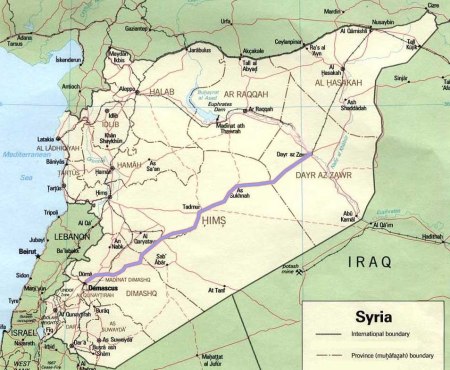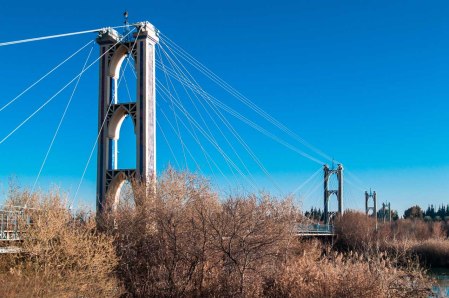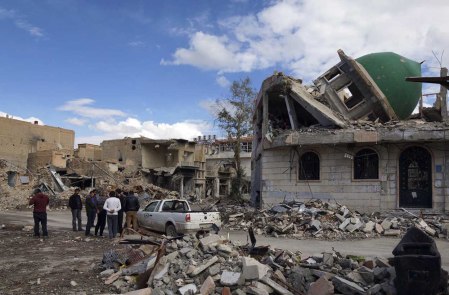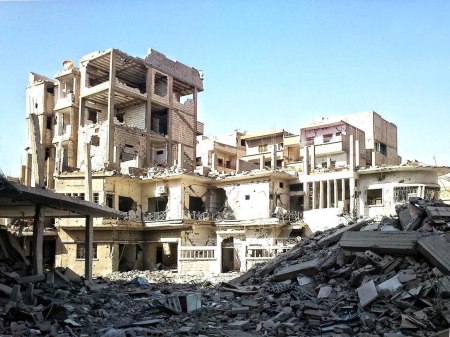Tareq al Abd As-Safir
As-Safir headed to Deir ez-Zor in pursuit of gathering details on life in the State of Goodness (Wilayat al-Khair), and that is what our reporter found out:
Deir ez-Zor, the city of oil, wheat, and cotton, known also for its beautiful suspension bridge across the magical Euphrates river, has lost all meaning of life. The city lost the meaning with everything what is now occurring on a daily basis in the most heated area in Syria, on both temperature and military levels.
Traveling overland from Damascus to Deir ez-Zor would normally take five hours. In former times there have been other options, of course, such as flying through Qamishli, which would take three hours, or taking a ride on the river from Raqqa. But after three years of war these options are not available anymore. The only option left is to go through the desert on a trip that takes over 10 hours.

One has not to take this road alone, though. Dozens of people travel here daily, for different reasons, such as work or family visits. The trip will be of a special kind. One has to listen to a number of instructions before getting on the bus. Women have to carry veils with them and sit in the back. They should wear the veil along with black clothes to avoid angering the fighters of the IS (Islamic State) checkpoints. The driver might take dirty unpaved roads in order to avoid the checkpoints, which will increase travel time even more. The roads might lead to Raqqa or Mayadeen and Bukamal. Everything is possible, such as getting lost or the bus breaking down on the way. But if one is lucky, the bus can use the normal route which leads from Damascus to Homs, then Palmyra, bevor finally reaching Deir ez-Zor.
The mentioned route ends at a Syrian army checkpoint on the Panorama roundabout, since part of the city is still under government control. However, the areas under the control of IS can only be reached by passing through Raqqa or Mayadeen, then crossing the Euphrates river through the al-Siyasa bridge.
Life against all odds
The stories of recent events are being told vividly by the situation inside the city. Everything has changed there. Destruction is spread throughout the main streets toward al-Rashidiya, al-Nahr street, and al-Huweka. The Deir ez-Zor suspension bridge, one of the most important sites in the city, which most citizens passed daily, has been struck and destroyed in the middle.

The old souk (market) has fared no better. One can get killed by simply walking through it. The still intact neighborhoods shelter the displaced from the destroyed areas, which makes the neighborhoods even more miserable than they were before, and the danger of being bombed of shot is constant. In a nutshell, life in Deir ez-Zor can only be described as a nightmare.
Control of Deir ez-Zor is divided between the Syrian government and IS. The first is controlling the neighborhoods of al-Joura, al-Kousour, al-Muwazafin, and the military airport, while IS members spread throughout the rest of the neighborhoods and the entire countryside. Yet, no matter who is in control of the particular location, the circumstances of living are similar in both areas. Electricity is only available for a few hours a day, if ever, in a city where the temperature can reach 50 degrees Celsius (122 degrees Fahrenheit). The water situation is a bit better, but the Euphrates’ level has significantly decreased due to drought, dams, and the withholding of water by Turkey.
The telephone landlines are working just fine but the mobile network and the Internet only function every now and then. Fuel, however, seems to be abundant and it is distributed at a very cheap price.
Despite the difficulties of living, the people are coping somehow with these circumstances. Hassan, a 33-year-old employee, says, “We are economizing our food habits. We prepare enough meals for a single day, since the fridges are no longer working and the heat quickly ruins the food supply. Even though some have power generators, the poor are unable to own generators and the oil price increases on a daily basis. There’s nothing more we can do. There is only one hospital in the city, on the entrance of al-Sham road, and most of the doctors have already left.”
Sami, 29, who works as a teacher, explains how the people are adapting to the current situation, and tells: “Many of the shops have opened their doors even if they can’t offer much, and state institutions are functioning normally. A couple of weeks ago, we took the high school exams, and we are now preparing for university. Whenever the electricity goes out, people leave their houses and use simple lights to move. The Friday trip to the river is still a weekly ritual.”
“We are condemned to stay no matter what. Going to Damascus is very expensive and life there is even more expensive. I know many people who left for Damascus and ran out of their savings or were unable to find work and returned here.”
IS tries to earn the trust of the population
In the rest of the neighborhoods where IS is in control, the scene seems normal. This applies also to the countryside, with the exception of the tensions that rose a few days ago between the Shaitat tribe and the residents of neighboring villages. The Islamic State’s dealing with the people has changed after this incident. It closed dozens of roads and started establishing barriers, carrying out arrests amid residents’ concerns of mass executions.
As for the “revolution” activists, some declared their repentance and remained in the city under surveillance, while others preferred to depart, fearing arrest or execution. Some preferred to swear allegiance to IS and opt for militancy in dealing with their opponents.

A young man from the area, who preferred to remain anonymous, says: “The early days of the Islamic State’s control witnessed the public being content. The fact is that the organization’s control put an end to the chaos of weaponry in which the region sank as multiple battalions fought with IS. The groups that usually relied on stealing or smuggling oil were forced to either pledge allegiance and comply with the orders of the governor or just leave, as did most of the leaders of Jabhat al-Nusra and Ahrar al-Sham, the major factions that waged war against IS. This contentment, however, is plagued by concerns and tension over any act of betrayal or suppression against the residents similar to what is happening in neighboring Raqqa.”
“We are sick and tired of the multiplicity of authorities and the daily state of war and fighting. There are many families that have no place but these houses, and they cannot move and add to the number of displaced people who were originally here,” another man said.
A nurse in his 20s pointed out policies the IS commanders should introduce in order to gain the people’s trust, They would consist of controlling the chaos and distributing food aid. But whatever the expectations are, everybody knows that the present calm could at any moment turn into a vigorous war if residents disobey or raise the suspicion of IS. What happened with the already mentioned Shaitat tribe in the city of Shehil is a worrying example.
That IS has closed the Deir ez-Zor channel, which broadcasts news from the region, and has decreed new work conditions, could be a bad omen. Many fear that the militants will gradually harden their rule, as they did in Raqqa.
No one knows what lies in store for the people of the Euphrates and for a city that has been marred by tragic events for decades amid the absence of major development projects. The occurrence of successive catastrophic droughts and the three years of war appear to be just the start of their trial. Accepting reality and trying to survive somehow has become the only option in Deir ez-Zor. It is as if this city is destined to continuously witness tragedies and wars.

As-Safir headed to Deir ez-Zor in pursuit of gathering details on life in the State of Goodness (Wilayat al-Khair), and that is what our reporter found out:
Deir ez-Zor, the city of oil, wheat, and cotton, known also for its beautiful suspension bridge across the magical Euphrates river, has lost all meaning of life. The city lost the meaning with everything what is now occurring on a daily basis in the most heated area in Syria, on both temperature and military levels.
Traveling overland from Damascus to Deir ez-Zor would normally take five hours. In former times there have been other options, of course, such as flying through Qamishli, which would take three hours, or taking a ride on the river from Raqqa. But after three years of war these options are not available anymore. The only option left is to go through the desert on a trip that takes over 10 hours.

One has not to take this road alone, though. Dozens of people travel here daily, for different reasons, such as work or family visits. The trip will be of a special kind. One has to listen to a number of instructions before getting on the bus. Women have to carry veils with them and sit in the back. They should wear the veil along with black clothes to avoid angering the fighters of the IS (Islamic State) checkpoints. The driver might take dirty unpaved roads in order to avoid the checkpoints, which will increase travel time even more. The roads might lead to Raqqa or Mayadeen and Bukamal. Everything is possible, such as getting lost or the bus breaking down on the way. But if one is lucky, the bus can use the normal route which leads from Damascus to Homs, then Palmyra, bevor finally reaching Deir ez-Zor.
The mentioned route ends at a Syrian army checkpoint on the Panorama roundabout, since part of the city is still under government control. However, the areas under the control of IS can only be reached by passing through Raqqa or Mayadeen, then crossing the Euphrates river through the al-Siyasa bridge.
Life against all odds
The stories of recent events are being told vividly by the situation inside the city. Everything has changed there. Destruction is spread throughout the main streets toward al-Rashidiya, al-Nahr street, and al-Huweka. The Deir ez-Zor suspension bridge, one of the most important sites in the city, which most citizens passed daily, has been struck and destroyed in the middle.

The old souk (market) has fared no better. One can get killed by simply walking through it. The still intact neighborhoods shelter the displaced from the destroyed areas, which makes the neighborhoods even more miserable than they were before, and the danger of being bombed of shot is constant. In a nutshell, life in Deir ez-Zor can only be described as a nightmare.
Control of Deir ez-Zor is divided between the Syrian government and IS. The first is controlling the neighborhoods of al-Joura, al-Kousour, al-Muwazafin, and the military airport, while IS members spread throughout the rest of the neighborhoods and the entire countryside. Yet, no matter who is in control of the particular location, the circumstances of living are similar in both areas. Electricity is only available for a few hours a day, if ever, in a city where the temperature can reach 50 degrees Celsius (122 degrees Fahrenheit). The water situation is a bit better, but the Euphrates’ level has significantly decreased due to drought, dams, and the withholding of water by Turkey.
The telephone landlines are working just fine but the mobile network and the Internet only function every now and then. Fuel, however, seems to be abundant and it is distributed at a very cheap price.
Despite the difficulties of living, the people are coping somehow with these circumstances. Hassan, a 33-year-old employee, says, “We are economizing our food habits. We prepare enough meals for a single day, since the fridges are no longer working and the heat quickly ruins the food supply. Even though some have power generators, the poor are unable to own generators and the oil price increases on a daily basis. There’s nothing more we can do. There is only one hospital in the city, on the entrance of al-Sham road, and most of the doctors have already left.”
Sami, 29, who works as a teacher, explains how the people are adapting to the current situation, and tells: “Many of the shops have opened their doors even if they can’t offer much, and state institutions are functioning normally. A couple of weeks ago, we took the high school exams, and we are now preparing for university. Whenever the electricity goes out, people leave their houses and use simple lights to move. The Friday trip to the river is still a weekly ritual.”
“We are condemned to stay no matter what. Going to Damascus is very expensive and life there is even more expensive. I know many people who left for Damascus and ran out of their savings or were unable to find work and returned here.”
IS tries to earn the trust of the population
In the rest of the neighborhoods where IS is in control, the scene seems normal. This applies also to the countryside, with the exception of the tensions that rose a few days ago between the Shaitat tribe and the residents of neighboring villages. The Islamic State’s dealing with the people has changed after this incident. It closed dozens of roads and started establishing barriers, carrying out arrests amid residents’ concerns of mass executions.
As for the “revolution” activists, some declared their repentance and remained in the city under surveillance, while others preferred to depart, fearing arrest or execution. Some preferred to swear allegiance to IS and opt for militancy in dealing with their opponents.

A young man from the area, who preferred to remain anonymous, says: “The early days of the Islamic State’s control witnessed the public being content. The fact is that the organization’s control put an end to the chaos of weaponry in which the region sank as multiple battalions fought with IS. The groups that usually relied on stealing or smuggling oil were forced to either pledge allegiance and comply with the orders of the governor or just leave, as did most of the leaders of Jabhat al-Nusra and Ahrar al-Sham, the major factions that waged war against IS. This contentment, however, is plagued by concerns and tension over any act of betrayal or suppression against the residents similar to what is happening in neighboring Raqqa.”
“We are sick and tired of the multiplicity of authorities and the daily state of war and fighting. There are many families that have no place but these houses, and they cannot move and add to the number of displaced people who were originally here,” another man said.
A nurse in his 20s pointed out policies the IS commanders should introduce in order to gain the people’s trust, They would consist of controlling the chaos and distributing food aid. But whatever the expectations are, everybody knows that the present calm could at any moment turn into a vigorous war if residents disobey or raise the suspicion of IS. What happened with the already mentioned Shaitat tribe in the city of Shehil is a worrying example.
That IS has closed the Deir ez-Zor channel, which broadcasts news from the region, and has decreed new work conditions, could be a bad omen. Many fear that the militants will gradually harden their rule, as they did in Raqqa.
No one knows what lies in store for the people of the Euphrates and for a city that has been marred by tragic events for decades amid the absence of major development projects. The occurrence of successive catastrophic droughts and the three years of war appear to be just the start of their trial. Accepting reality and trying to survive somehow has become the only option in Deir ez-Zor. It is as if this city is destined to continuously witness tragedies and wars.

Keine Kommentare:
Kommentar veröffentlichen